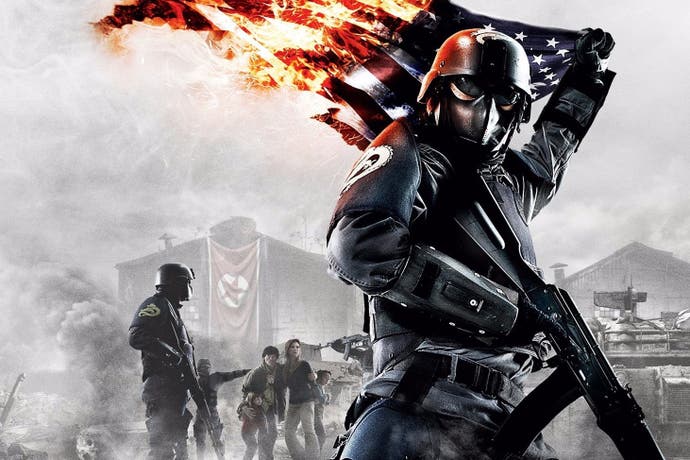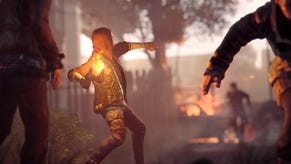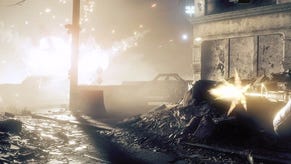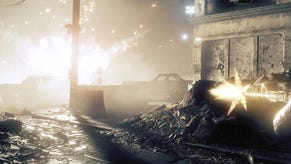Homefront: The Revolution is surprisingly nutty
Co-op multiplayer revealed, Norks n'all.
"That's the last we'll see of the Norks today."
If you've cast an eye over the bombed out cityscape of Homefront: The Revolution's open world and thought it all looks a little too miserable, rest assured there's a streak of very British humour running through Deep Silver and Dambuster Studios' shooter. The dilapidated streets of Philadelphia are patrolled by small mobs of North Korean soldiers, part of an invading force that has brought the city to its knees and one that you, as the resistance, are struggling to push back. Time's short on this urban battlefield, and sometimes you need an abbreviation that's easy to spit out when the enemy draws near.
So, why not call them Norks?
Norks in the alleyway. Norks on the roof. Norks in armour, padding up the stairs. Norks running around in pairs. Norks pretty much everywhere.
Yup. Norks. I'm not sure the world needs an all-new racial slur, but I'm always up for a bit more end-of-pier smut in our po-faced shooters. After almost two hours of being bombarded with NPC chatter of weaponised breasts in a co-op session of Homefront: The Revolution, I turned to the developer who was guiding us through the three missions to check if my ears were deceiving me. They weren't, he admitted with a mixture of embarrassment and pride. What a strange game this is turning out to be.
Homefront: The Revolution isn't a sequel to THQ and Kaos' scrappy 2011 first person shooter, choosing instead to borrow the name and premise to do something very different. Set in a series of open-world maps strung together with more linear levels, it's a shooter with an emphasis on canny survival rather than cinematic excess, where you're fighting with homespun weaponry and scarce resources against a technologically superior enemy.
There's something of Far Cry in the improvisation implicit in its open world warfare, something of Half-Life 2's City 17 in the bombed out beauty of Philadelphia, but when I got to play its campaign last August I was impressed with how it felt very much like its own thing; a shooter with identity and purpose alongside a suite of neat ideas.

Now that we're able to play Homefront: The Revolution's multiplayer, much of that persists. Rather than getting drawn into a competitive PvP scene that's somewhat oversubscribed, Dambusters is trying something different again: a collection of co-operative missions with their own persistent levelling, running deep with role-playing systems. It might come as a disappointment to anyone who remembers the quick-fire deathmatch brilliance of TimeSplitters, the work of Dambuster Studios' past incarnation Free Radical Design, but it's an interesting concept delivered with some conviction.
You start by creating your own character, picking from a long list of vocations that grant you a starting perk. It allows for some wonderful flavour: the docker takes long to bleed out, the pharmacist grants revived allies a short speed boost while a football player can grit their teeth through the pain. There's even a video game developer amidst the long starting list - 'a lover, a fighter and an exemplary specimen of humanity', so the descriptive text goes before detailing a perk that lowers all tier unlocks. No-one's too sure if this little in-joke will make it into the final build, though I appreciate the brief levity it offers.
Homefront: The Revolution needs it, because aside from those little flashes of colour - and the offhand mention of all those Norks, of course - it can be a relentlessly grim experience. Early on, as you're yet to work your way through the skill tree that underpins your character's persistent progression, it's easy to be overwhelmed by the mobs of militia and their slick arsenal: as in the main campaign, you take on the neatly turned out North Korean forces with grubby home-made weapons and tools, from teddy bears rigged up with firecrackers that serve as a diversionary tactic to radio controlled cars looted from Maplins and pieced together with instructions from The Anarchist Cookbook.
Team dynamics are slow to reveal themselves - especially if, like me, you're stuck with a team that's frustratingly mute - but as the skill-tree slowly branches, it creates little meshes between each player's particular talents. After a couple of matches I was able to effortlessly tag enemy patrols and vehicles, marking them up for the entire team, while another player was able to scavenge more ammo. I'd even got a special new beanie hat, and felt far better equipped for the battles ahead.
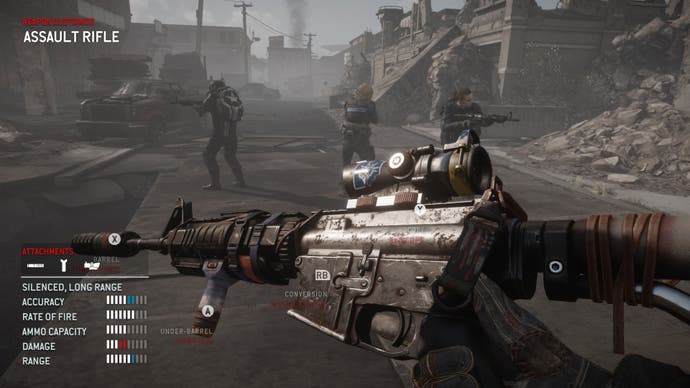
There's loot in Homefront: The Revolution, though you'll get it by way of packs available to buy at the end of each mission, with each one containing packs of cards that unlock special equipment. You buy them with in-game currency and, predictably, there's the option to spend real cash in order to attain unlocks that little faster. It's hardly unprecedented, and Dambuster Studios is, of course, at pains to point out it's not pay to win and is rather means for more time-strapped players.
They're at least committed to long-term support for the co-op mode, with some 12 maps promised in the initial game and with that number looking to double post-launch. In the small selection we played, there's an enjoyable if safe selection of objectives, from scoping out and clearing out a deserted city centre, finding ourselves under siege towards the suburbs before beating a hasty retreat, and escorting a vehicle through an occupied zone.
They're missions that will be forming the closed beta that's launching tomorrow, with an open beta due sometime before Homefront: The Revolution's final release this May. Right now, it looks like Dambuster Studios might need a little more time to get everything ship-shape. Alongside its own comic touches, there are a few less welcome slapstick moments: allies' legs frequently spin around like windmills as they levitate two feet from the floor, and at one point a heavily armed Goliath tank rolls down the street on two wheels in an improbable piece of stuntwork. Errant Norks are the least of Homefront's worries right now.
There's time to fix things, though, and to get it right. Once you get past its slightly generic aesthetic, Homefront: The Revolution proposes one of the more interesting shooters in some time, and it's the first chance we'll get to play a full-fledged game from the team once known as Free Radical since 2008's troubled Haze. Despite some worrying signs towards the end of coming up to five years of development, I remain cautiously optimistic that this strange reboot will do better justice to the talents of the noted Nottingham developer.
